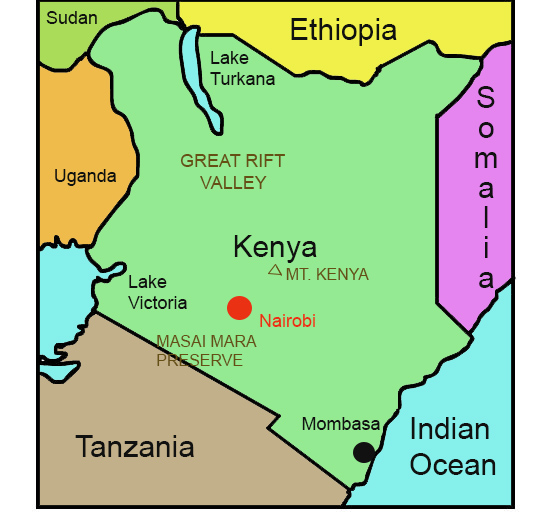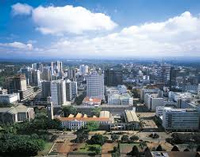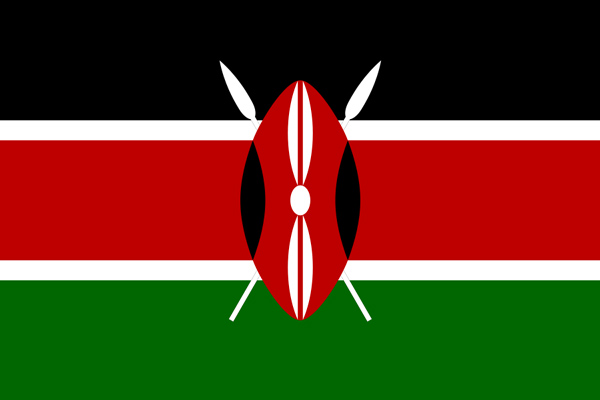Click the points on the map to learn more.

 |
Nairobi, KenyaNairobi, Kenya's capital and largest city, is home to 3.4 million people. Nairobi was originally formed as a rail depot for the British in 1899, before becoming a top destination for tea and coffee. The city's high altitude makes it one of the coolest African capital cities, with average temperatures of between 60-70 degrees. Nairobi is the only major city in the world with its own game preserve (Nairobi National Park). |
| Back to Map | |
 |
Mombasa, KenyaAlmost one million people live in Mombasa, Kenya's main port city built on an island on its eastern coast. Mombasa was originally an Arab city before being taken by the Portuguese in 1592. by 1895, it had fallen into British hands. In 1963, when Kenya declared independence from the United Kingdom the city finally became a possession of Kenya. Today, Mombasa is Kenya's second largest city and is close to some of east Africa's most beautiful beaches. |
| Back to Map | |
 |
Maasai Mara Wildlife PreserveThe Maasai Mara stretches across 580 square miles, and is home to over 95 species of mammals and at least 570 species of birds. The Maasai Mara is famous for its annual wildebeest migration in late summer, when over 1.5 million wildebeests migrate from Kenya to Tanzania. The preserve is home to lions, leopards, cheetahs, giraffes, elephants, zebra and gazelles, among other mammals. The Wildlife Reserve sit s on the ancestral land of the Maasai Mara people. |
| Back to Map | |
 |
Lake TurkanaLake Turkana, Kenya's largest lake, has an area of 2,473 square miles. The climate in the area around the lake is especially hot and dry. Lake Turkana is the world's largestpermanent desert lake, and the world's largest alkaline lake. |
| Back to Map | |
 |
Great Rift ValleyThe Great Rift Valley stretches over 6000 kilometers across the Middle East and Africa. Geologists are currently studying the East African Rift System (EARS), have discovered that the Great Rift Valley is the result of two tectonic plates moving away from each other, resulting in a widening crack in the earth's surface. Lake Turkana in the north sits directly inside of Kenya's portion of the Great Rift Valley. |
| Back to Map | |
 |
Mount KenyaMount Kenya is the highest peak in Kenya, and the second highest peak in all of Africa. Only Mt. Kilimanjaro is higher. Mount Kenya's highest summit lies at an altitude of 17,057 feet. Mount Kenya boasts several different summits, as well as eleven small and shrinking glaciers. Mount Kenya is located directly on the equator about 93 miles northeast of Nairobi.
|
| Back to Map | |
 |
Lake VictoriaAt 26,600 square miles in size, Lake Victoria is Africa's largest lake, and the largest tropical lake in the world, and the second largest freshwater lake in the world. Only Lake Superior in the United States is larger. Lake Victoria is shallow compared to other large lakes with an average depth of 140 feet and a maximum depth of 276 feet. Much of the lake's original ecosystem has been destroyed by invasive species such as the nile perch and the water hyacinth. |
| Population: | 45,925,301 |
| Area: | 224,445 square miles |
| Capital City: | Nairobi |
| Largest City: | Nairobi |
| Currency: | Kenyan Shillings |
| Official Language: | English, Kiswahili |
| GDP (Gross Domestic Product) | $141.9 billion |
- Swahili, Kenya’s national language, originated on the East African coast and is now the most widely spoken African language
- Agriculture accounts for 25% of Kenya’s GDP, and about 80% of Kenya’s population works in the agricultural sector
- Kenya’s population represents over 40 different unique ethnic groups
- One of Kenya’s largest exports is coffee. It exports over 100 million pounds of coffee each year.
- Kenya achieved independence from Great Britain in 1963
- Some of humankind’s oldest ancestors have been discovered in the area around Lake Turkana in the north - ‘Kenya Man’ dates back 3.2 million years
- Kenya is currently home to approximately half a million refugees, primarily from neighboring African countries
- Three-quarters of Kenya’s population resides in the Kenyan countryside
- Kenya is one of thirteen countries in the world on the equator
-Kenya is home to 6 UNESCO World Heritage Sites, including Lake Turkana National Park and Mount Kenya National Park
|
|
 |
|
| The black band represents the color of the majority population, the red band represents bloodshed, the green band symbolizes Kenya’s national wealth, and the white stands for peace. The Maasai warrior shield and spears represent the defense of freedom. | |